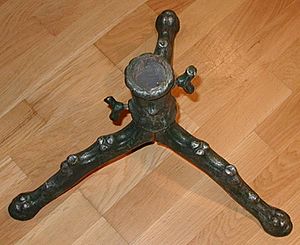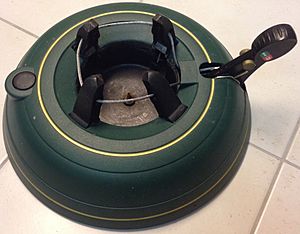Christmas tree stand facts for kids
A Christmas tree stand is a special holder that helps a real or artificial Christmas tree stand upright. People have been using these stands since at least 1876, and their designs have changed a lot over the years. Stands for real trees often have a small container for water. This helps keep the tree fresh. Some old or unique Christmas tree stands can even be quite valuable to collectors!
Contents
History of Christmas Tree Stands
Christmas tree stands have been around for a long time. One of the earliest mentions was in 1876. That same year, a man named Hermann Albrecht from Philadelphia received two of the first patents for Christmas tree stands in the United States.
In 1892, a carpenter named Edward Smith shared an idea for a homemade Christmas tree stand. He described how to make a simple stand from a board with a tiny fence around it. This showed that people were already thinking about creative ways to support their trees.
Later, in 1919, a magazine called Popular Science featured a new kind of stand. This stand had a wide, cone-shaped base. It could hold water and the tree trunk. The water made the stand heavy, which kept the tree steady. It also helped the tree stay fresh and green for longer.
How Christmas Tree Stands Are Designed
Many Christmas tree stands for real trees have a special water-well. This is important because real trees need water to stay fresh and not dry out. Experts say that giving a natural Christmas tree lots of water is key to making it last. They often suggest using a stand with a large water container.
A study by a plant expert at Washington State University looked at many different tree stands. The study found that only a few of the stands could hold enough water for larger Christmas trees. This shows how important it is to pick the right stand to keep your tree healthy.
Not all tree stands are bought from a store. Some people make their own! For example, you could use an old bucket or a large can. Another creative idea is to turn an old cast iron garden pot into a tree stand.
Different Kinds of Tree Stands
Christmas tree stands sometimes had a special job for aluminum Christmas trees. These artificial trees became popular in the past. To light them up, people often used a "color wheel" placed on the floor under the tree. This wheel had different colored sections. When it spun, a light shone through it, casting colorful patterns onto the tree's shiny branches. Sometimes, the tree stand itself would even rotate, making the light show even more exciting!
Valuable Old Christmas Tree Stands
Some Christmas tree stands were made with unique designs. These special stands can be worth money in the antiques market today. For example, there was a decorative stand from the 1950s. It was made of tin with colorful holiday pictures printed on it using a method called lithography. A stand like this could sell for a good amount of money to collectors.
See also



